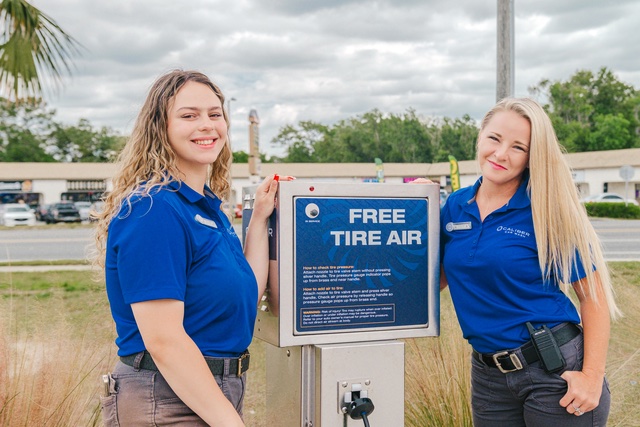
Caliber is excited to announce that a new tire air station will be set up at each Caliber Car Wash location! Customers that purchase any wash will now be able to pull in, connect the hose to their tire air valve, and press a button to begin filling your tire with additional air. See below for some FAQs about tire pressure.
How do I check my tire pressure?
There’s a tire air gauge on the tire air hose. If possible, it is best to check the tire pressure when the tires are cold opposed to after being driven.
- Remove the cap from the air valve on the tire and put it somewhere you won’t lose it.
- Press the tire gauge against the open valve stem for a second or two. It’s normal to hear a hiss of air.
- Read the air pressure gauge. For manual gauges, like the one that will be attached to the air hose, a bar indicates the pressure by how far it was pushed out.
- Compare this number with the recommended tire pressure.
- Replace the tire’s air valve cap. (Hold off on this step if you need to adjust the air pressure.)
- Repeat this process for each tire.
How do I use a tire pressure machine?
Follow this step-by-step guide that details how to inflate your tires:
Park close enough to the air compressor so you can reach all four tires with the hose.
- If the valve caps are still on, remove them.
- Press the button on the top left corner of the tire air machine
- Press the hose nozzle down on the valve stem. Air will begin to flow. You should notice the tire inflating and feel air flowing through the hose.
- Remove the hose fitting or release the inflation lever. Check the air pressure, as described above, using the gauge on the hose or your own tire gauge.
- Repeat steps 3 and 4 as needed until the tire is inflated to the correct psi.
- Repeats steps 3-5 for the vehicle’s other tires.
- Once the tires are inflated properly, replace the valve caps.
Tip: If you hear or feel air coming out of the hose nozzle while you’re trying to fill the tire, Cars.com says you should check that it is properly connected to the tire valve stem.
What should my tire pressure be?
Not all cars need the same amount, but usually around 32 to 35 psi when the tires are cold. If you are unsure what your tire pressure should be, there is usually a sticker on the inside of the driver’s door or in the car’s manual that should tell you exactly what psi your car needs.
Can I overfill my tire with air?
Yes! It is dangerous to overfill your tires with air. If you do this, simply leave the cap from the air valve out until your tire deflates on its own. If you choose to drive with overinflated tires, you risk a blowout, compromised safety features such as anti-lock braking, and more susceptible from damage from potholes or curbs.
Why does my tire pressure decrease when it’s cold outside?
Tire pressure can decrease about 1 PSI (pounds per square inch) for every 10 degrees the temperature drops. It’s not due to air escaping, but rather the air inside the tire condenses, taking up less space when it’s cold. This is temporary because driving will heat up the tire and increase the tire’s pressure.
How do I know how much air to put in my tires?
To ensure that you don’t overinflate your tires, it is imperative to continuously check your tire pressure during the process of inflation. Once you have determined your desired psi, continue putting air in your time and checking the gauge to see the tire’s current psi. Once you have reached your car’s desired psi, you may quit inflating your tire.
